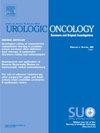IDENTIFYING BARRIERS TO TIMELY FOLLOW-UP AFTER ELEVATED PSA SCREENING: A RETROSPECTIVE ANALYSIS OF A LARGE HEALTHCARE SYSTEM
IF 2.4
3区 医学
Q3 ONCOLOGY
Urologic Oncology-seminars and Original Investigations
Pub Date : 2025-03-01
DOI:10.1016/j.urolonc.2024.12.025
引用次数: 0
Abstract
Introduction
Prostate cancer is the most common solid organ cancer and the second leading cause of cancer-related mortality among American men. Early detection and timely treatment are crucial for effective management. Despite updated guidelines from the United States Preventive Services Task Force in 2018 recommending shared decision-making for PSA screening in men aged 55-69 years, barriers to timely follow-up care persist. This study aims to examine elevated PSA follow-up within our healthcare system and identify barriers to timely diagnosis of prostate cancer.
Methods
We analyzed data from the Mass General Brigham's Enterprise Data Warehouse, focusing on patients with elevated PSA levels from 2018-2021. Timely follow-up was defined as having a urologist appointment, prostate biopsy, or prostate MRI within 6 months of diagnosis. The location of elevated PSA diagnosis was categorized as academic medical centers versus community sites. Univariable and multivariable analyses were conducted to identify factors impacting follow-up.
Results
Our cohort included 28,346 patients, with 50.30% receiving timely follow-up, 15.02% experiencing untimely follow-up, and 34.69% having no follow-up. Multivariable analysis showed that patients diagnosed at academic medical centers were more likely to receive follow-up care (OR=1.39, 95%CI 1.30-1.48). Sensitivity analysis incorporating two major community hospitals into the academic category revealed even higher odds of timely follow-up (OR=1.61, 95%CI 1.51-1.73).
Conclusions
Significant variation exists in follow-up rates between academic medical centers and community sites, underscoring the need for strategies to ensure timely and consistent prostate cancer follow-up care across all facilities. Addressing these disparities can enhance timely care delivery and improve patient outcomes.
确定psa筛查升高后及时随访的障碍:对大型医疗保健系统的回顾性分析
前列腺癌是最常见的实体器官癌,也是美国男性癌症相关死亡的第二大原因。早期发现和及时治疗对有效管理至关重要。尽管美国预防服务工作组在2018年更新了指南,建议55-69岁男性进行PSA筛查的共同决策,但及时随访护理的障碍仍然存在。本研究旨在检查我们的医疗保健系统中PSA升高的随访,并确定及时诊断前列腺癌的障碍。方法:我们分析了麻省总医院布里格姆企业数据仓库的数据,重点关注2018-2021年PSA水平升高的患者。及时随访定义为在诊断后6个月内进行泌尿科医生预约、前列腺活检或前列腺MRI检查。PSA诊断升高的地点分为学术医疗中心和社区地点。通过单变量和多变量分析确定影响随访的因素。结果纳入28346例患者,其中及时随访占50.30%,未及时随访占15.02%,未随访占34.69%。多变量分析显示,在学术医疗中心诊断的患者更有可能接受随访治疗(OR=1.39, 95%CI 1.30-1.48)。将两家主要社区医院纳入学术类别的敏感性分析显示,及时随访的几率更高(OR=1.61, 95%CI 1.51-1.73)。结论学术医疗中心和社区医疗中心的随访率存在显著差异,强调需要制定策略,确保所有医疗机构的前列腺癌随访护理及时一致。解决这些差异可以加强及时提供护理并改善患者的治疗效果。
本文章由计算机程序翻译,如有差异,请以英文原文为准。
求助全文
约1分钟内获得全文
求助全文
来源期刊
CiteScore
4.80
自引率
3.70%
发文量
297
审稿时长
7.6 weeks
期刊介绍:
Urologic Oncology: Seminars and Original Investigations is the official journal of the Society of Urologic Oncology. The journal publishes practical, timely, and relevant clinical and basic science research articles which address any aspect of urologic oncology. Each issue comprises original research, news and topics, survey articles providing short commentaries on other important articles in the urologic oncology literature, and reviews including an in-depth Seminar examining a specific clinical dilemma. The journal periodically publishes supplement issues devoted to areas of current interest to the urologic oncology community. Articles published are of interest to researchers and the clinicians involved in the practice of urologic oncology including urologists, oncologists, and radiologists.

 求助内容:
求助内容: 应助结果提醒方式:
应助结果提醒方式:


